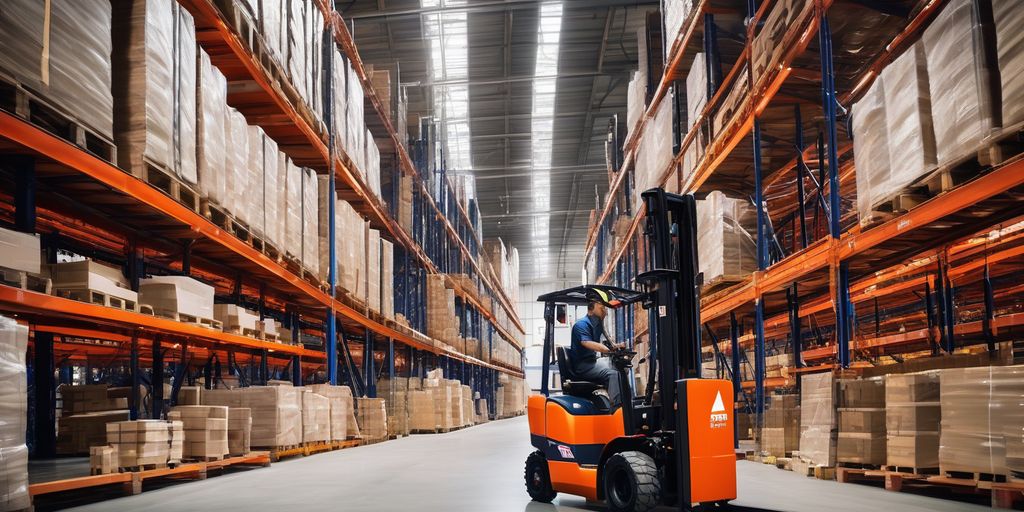The forklift industry is undergoing a significant transformation due to rapid technological advancements and changing market demands. With a global valuation of $62 billion in 2022, the industry is poised for further growth and innovation. This article explores the top ten trends in forklift technology that are reshaping how businesses handle material operations, enhance safety, and improve efficiency.
Key Takeaways
- Increased automation is enhancing operational efficiency and reducing the need for manual labor.
- The integration of Autonomous Mobile Robots (AMRs) is revolutionizing material handling by automating complex tasks.
- All-electric forklifts are gaining popularity due to their environmental benefits and lower operating costs.
- Advanced data analytics are being used to optimize forklift operations and predict maintenance needs.
- Emerging technologies like telematics and augmented reality are improving the safety and productivity of forklift operations.
1. Automation
The integration of automation in the forklift industry is a significant trend that is reshaping how operations are conducted in warehouses and distribution centers. Automation enhances operational efficiency by minimizing the need for human intervention, which not only speeds up processes but also reduces the likelihood of errors. This shift towards automation is part of a broader movement to incorporate advanced technology to meet the evolving demands for efficient and cost-effective logistics solutions.
- Reduction in overhead costs: Automation helps in saving substantial amounts on overhead expenses.
- Decrease in work-related accidents: By reducing human intervention, automation also lowers the risk of accidents in the workplace.
- Enhancement in productivity: Automated systems, such as fully automated storage and retrieval systems, significantly boost productivity levels.
Automation is not just a temporary trend but a fundamental shift that is here to stay in the material handling industry.
2. Autonomous Mobile Robots
Autonomous Mobile Robots (AMR) represent a significant leap in forklift technology, operating independently without the need for fixed guidance systems. Unlike their predecessors, AMRs are equipped with advanced sensors and intelligent systems, allowing them to navigate dynamically and interact with their environment. This capability makes them highly adaptable to various warehouse and manufacturing settings, where they can perform tasks through programming or remote guidance.
Key Benefits of AMRs:
- Increased efficiency in material handling
- Enhanced flexibility in operation
- Reduced dependency on manual labor
- Improved safety through autonomous navigation
AMRs leverage artificial intelligence to learn and adapt to new environments, enhancing their effectiveness in complex logistical operations.
These robots are particularly useful in environments that undergo frequent changes and require a high degree of adaptability. By eliminating the need for infrastructure modifications for installation, AMRs offer a cost-effective solution to modernize operations and enhance overall productivity.
3. All-Electric Forklifts
The shift towards all-electric forklifts is driven by the need to reduce emissions and operating costs, aligning with global sustainability goals. These forklifts, powered by advanced battery technology, offer significant advantages over traditional internal combustion engine models. Electric forklifts are not only more environmentally friendly but also cost-effective in the long run due to lower maintenance and fuel costs.
Key Benefits:
- Reduced emissions: Essential for operations in environmentally sensitive areas.
- Lower operating costs: Thanks to minimal maintenance and no fuel expenses.
- Quieter operation: Ideal for indoor environments.
- Enhanced efficiency: Improved batteries enhance operational uptime and productivity.
Electric forklifts with improved batteries upgrade operating efficiency by reducing downtime, requiring less maintenance, and running more quietly and smoothly.
The market for electric forklifts is expanding rapidly, with a significant increase in adoption rates due to their economic and ecological benefits. As technology progresses, these vehicles are set to become even more prevalent in warehouses and industrial settings around the world.
4. Data Analytics
Data analytics is increasingly pivotal in the forklift industry, enhancing operational efficiency and safety. By analyzing data from sensors on forklifts, companies can optimize usage, predict maintenance needs, and improve overall warehouse management.
Optimizing Scheduling and Warehouse Management
Data from forklifts is crucial for optimizing work schedules and inventory management. It helps ensure that material handling tasks are efficient and timely, identifying areas for improvement.
Predictive Maintenance
Predictive analytics utilize data from forklift sensors to forecast maintenance needs. This proactive approach minimizes downtime and prevents unplanned repairs, crucial for maintaining continuous operations.
Integrating IoT and analytics into forklift operations not only streamlines processes but also enhances safety and performance. The SMART, connected warehouse is no longer a concept but a reality, with data-driven decisions at its core.
5. Telematics
Telematics, combining telecommunications and informatics, is revolutionizing the way forklift fleets are managed. By installing sensors on forklifts and integrating with enterprise resource planning (ERP) tools, businesses can achieve real-time tracking and management of their fleet. This technology not only enhances safety by monitoring vehicle performance but also helps in reducing operational costs and optimizing overall operations. Forklift telematics data includes vital statistics that can be gathered by GPS and sensors technology in fleets, allowing for enhanced decision-making and efficiency.
Key Benefits of Forklift Telematics:
- Real-time location tracking of forklifts
- Improved fleet management through data analytics
- Enhanced safety protocols and reduced accident risks
- Optimization of maintenance schedules based on actual usage
Telematics technology is still evolving, making it a crucial area to watch as SMART warehouses adapt to new challenges and opportunities.
6. Augmented Reality
Augmented Reality (AR) is revolutionizing the forklift industry by enhancing operator training and guidance. AR headsets allow trainees to simulate forklift operations in a virtual environment, which is crucial for safe and effective training without the risks associated with physical operation. This technology overlays digital information, such as navigation paths and load weight indicators, directly into the operator's field of view, promoting precise and safe operations.
The potential of AR to reduce training costs and improve safety is significant, as it provides real-time information and visual cues without causing distractions.
Key Benefits of AR in Forklift Operations:
- Enhanced training efficiency and safety
- Real-time operational guidance
- Reduction in training and operational costs
- Improved accuracy in material handling
7. Robotics
The integration of robotics in the forklift industry marks a significant shift towards more efficient and safer operations. Robotic systems are increasingly being adopted to handle complex tasks such as navigation, palletizing, and inventory management. These systems not only enhance productivity but also reduce the risk of accidents and injuries.
- Enhanced navigation and precision: Robotics technology allows forklifts to navigate warehouses with high accuracy, avoiding obstacles and efficiently organizing inventory.
- Automated palletizing: Robotic arms can be equipped to perform repetitive tasks like stacking and unstacking pallets, which minimizes human error and fatigue.
- Improved safety features: Robotics include sensors and software that help prevent collisions and ensure safe interactions between humans and machines.
The adoption of robotics is transforming the way materials are handled, making operations not only faster but also significantly safer.
8. Alternative Power Sources
As the industry shifts away from traditional gasoline and diesel, alternative power sources for forklifts are gaining traction. Electric forklifts are celebrated for their low noise levels, zero emissions, and reduced maintenance costs. Moreover, hydrogen fuel cells are emerging as a powerful alternative, offering longer run times and faster refueling than conventional batteries.
The transition to electric and hydrogen-powered forklifts represents a significant step towards sustainability in material handling.
Key Advantages of Alternative Power Sources:
- Zero emissions: Essential for reducing environmental impact.
- Lower operational costs: Due to less maintenance and cheaper energy sources.
- Faster refueling and longer run times: Particularly with hydrogen fuel cells.
The growing concerns about the sustainability of lithium mining are pushing the industry to explore these cleaner and more efficient technologies. As these technologies evolve, they promise to reshape the landscape of industrial material handling, making operations not only more sustainable but also more cost-effective.
9. Safety Enhancements
Safety enhancements in forklift technology focus on reducing the risk of accidents and improving the overall safety of the workplace. Automated warning systems play a crucial role in enhancing visibility and awareness, alerting operators to potential hazards. The integration of forklift anti-collision systems significantly reduces the risk of collisions and improves overall workplace safety.
Key Safety Features:
- Blind spot cameras
- Alarms and warning systems
- Flashing lights
- Speed limiters
- Seatbelts
- Fall protection
These features not only prevent operator accidents but also minimize equipment damage and costly downtime. Operator assist safety technology further empowers operators to maintain control while being acutely aware of their surroundings, ensuring a safer working environment.
10. Material Handling Innovations
In the realm of material handling, innovations are pivotal for enhancing safety and efficiency. The integration of new technologies and ergonomic designs in forklifts is transforming the industry. Innovations such as smart sensors, automated warning systems, and advanced operator training simulators are at the forefront of creating safer workplace environments. These advancements not only help in minimizing work-related accidents but also boost productivity by integrating modern technology with practical business tools.
The potential of automation in the material handling industry is immense, and it looks like it’s here to stay.
Furthermore, the introduction of fully automated storage and retrieval systems is a game-changer, significantly reducing costs and improving operational efficiency. The focus on ergonomic designs is also making forklifts more user-friendly and less prone to causing operator fatigue, which in turn helps in reducing the risk of accidents.
Conclusion
As we've explored the top trends in forklift technology, it's evident that the industry is undergoing a significant transformation. From the integration of automation and robotics to the shift towards electric power sources, these advancements promise to enhance efficiency, safety, and sustainability in material handling operations. Staying informed about these trends is crucial for businesses looking to optimize their operations and for professionals aiming to stay ahead in the field. The future of forklift technology is not just about adaptation but also about innovation, driving the industry towards a more efficient and environmentally friendly future.
Frequently Asked Questions
What are the key trends in forklift technology today?
The key trends include automation, autonomous mobile robots, all-electric forklifts, data analytics, telematics, augmented reality, robotics, alternative power sources, safety enhancements, and material handling innovations.
How is automation impacting the forklift industry?
Automation is significantly enhancing efficiency and safety in material handling operations by reducing reliance on manual labor and improving precision in tasks.
What benefits do all-electric forklifts offer?
All-electric forklifts reduce emissions, lower operating and maintenance costs, and are generally quieter and cleaner compared to traditional internal combustion engine forklifts.
What role do data analytics play in modern forklift operations?
Data analytics help in monitoring and optimizing forklift operations, enhancing productivity, and reducing operational costs through detailed data insights.
How are autonomous mobile robots (AMRs) transforming the forklift industry?
AMRs automate material handling processes, enhance productivity, and reduce the need for manual labor by autonomously navigating and performing tasks.
What are the latest safety enhancements in forklift technology?
Recent safety enhancements include improved operator training programs, better ergonomic designs, and advanced safety features like collision avoidance systems and enhanced visibility.



Leave a comment
This site is protected by hCaptcha and the hCaptcha Privacy Policy and Terms of Service apply.